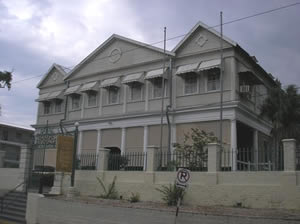Hibbert House /Headquarters House

Hibbert House /Headquarters House
Parish: Kingston
Headquarters House, the head office of the Jamaica National Heritage Trust, is located at 79 Duke Street, Kingston. It was built by Thomas Hibbert, a wealthy young English Merchant, in 1755. Thomas Hibbert arrived in Jamaica in 1734. He came from a wealthy Lancashire family which had considerable experience in commerce and manufacture and he too was probably eager to exploit the rich trading opportunities Jamaica presented.
According to the parish tax records for 1745, Thomas Hibbert was the joint tenant of a property in Waterlane, near the harbour in Kingston. His mercantile career had obviously begun. By 1752 he had acquired property on Orange Street, which was still reasonably close to the sea. At that time he was in partnership with Nathan Spring. By 1753 his financial status was such that he was able to buy land above the Parade Square and compete with three other merchants to build the most beautiful house in Kingston.
Headquarters House, therefore, was built as the dwelling house of Thomas Hibbert, as a result of a wager. The three other rivaling houses', "Constantine House", on High Hilborn Street, "Bull House" on North Street, and "Harmony Hall" on Hanover Street, have been long since destroyed.
Headquarters House or "Hibbert House", as it was known up to the time of the owner's death, stands as a reminder of the wealth and power of the Kingston Merchants in their glory days.
Thomas Hibbert was among the first of many wealthy merchants to commission a style of house which was to become an integral feature of the Jamaican architectural landscape. The house is built using the Georgian Style of architecture which had become very fashionable in England in the Eighteenth Century. This style of architecture reached Jamaica as a result of rich merchants like Thomas Hibbert who had settled in Jamaica and built their houses based on the English architectural styles.
The house is symmetrical, constructed of brick, stone and timber. The walls are of flemish bonded red brick with contrasting limestone quoins, which are pronounced on the exterior of the building. The front of the building has been altered, with the addition of beautiful Jamaican Vernacular fretwork which allows for some amount of privacy and yet allows you to enjoy the sea breeze.
The house is a two-storey building with a large basement used for storage, and an attic with dormer windows. The first floor was used as offices and entertainment, while the upper floor was used as bedrooms. To the back of the building are a courtyard and several outhouses.
Inside the house are several interesting features worthy of note. These include the fine brickwork in the basement and the exquisite staircase leading from the ground floor to the first.
Like many merchants of his time, Thomas Hibbert became involved in politics and was named Speaker of the House of Assembly in 1756. The temporary removal of the Capital of Jamaica from Spanish Town to Kingston in 1754 by Colonel Admiral Charles Knowles, resulted in the House of Assembly and Legislative Council holding meetings at Hibbert House from 1755 - 1758.
After Hibbert's death the house remained in private hands until it was purchased in 1814 by the War Office of the West Indies Regiment from the widow of Dr. Solomon Deleon, to serve as its headquarters and the residence of the General of the army garrisoned in Jamaica. It consequently became known as Headquarters House or General's House.
Due to its proximity to the harbour, and the view it commanded of the city the house was ideally located for it to be used as the headquarters for the army. Few adjustments were needed for it to serve this purpose, this included the construction of the crow's nest or sentinel on the roof of the building.
While Hibbert House served as the Headquarters House, several illustrious commanders resided there, those include Willoughby Cotton, who ordered the militia to crush the Slave Christmas Rebellion, led by Sam Sharpe in 1831; William Gomm who founded the Military Hill Station at New Castle, St. Andrew in 1841; Luke O'Connor, Commander in Chief of the Military Forces which put down the Morant Bay Rebellion of 1865; and it was also from Headquarters House, that Governor
John Eyre organized his attack on St. Thomas to crush the Morant Bay Rebellion.
In 1872, with the permanent removal of the Capital from Spanish Town to Kingston, Headquarters House was purchased by the Government for five thousand pounds (£5000) Sterling. It became the permanent seat of the Jamaica Legislation from 1872 until 1960. Prior to this, it was used as the Offices of Colonial Secretary. Since 1983, Headquarters House has been used as the head office of the Jamaica National Heritage Trust. The building has survived social, political and structural changes as well as the forces of nature to become a truly national historic treasure, worthy of preservation.
SHOWCASE
|
SHOWCASE
|
SHOWCASE
|


